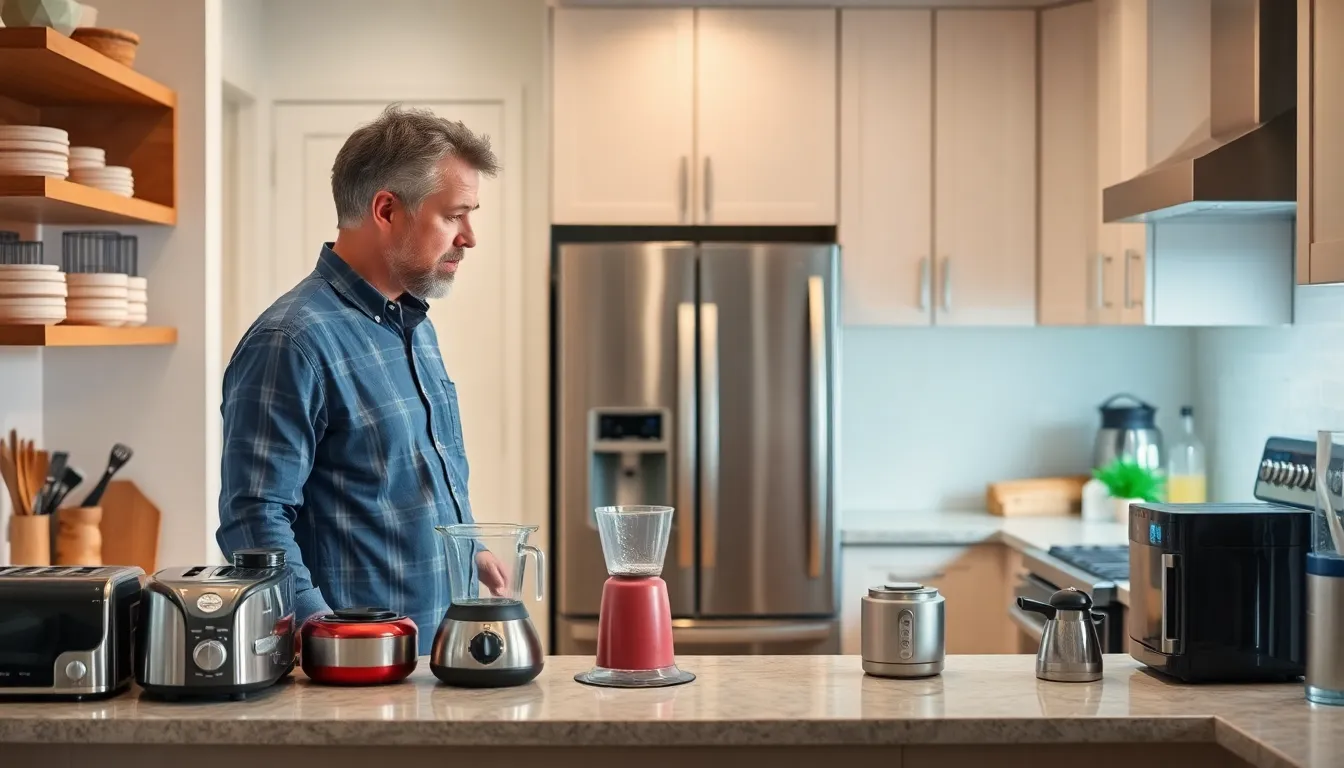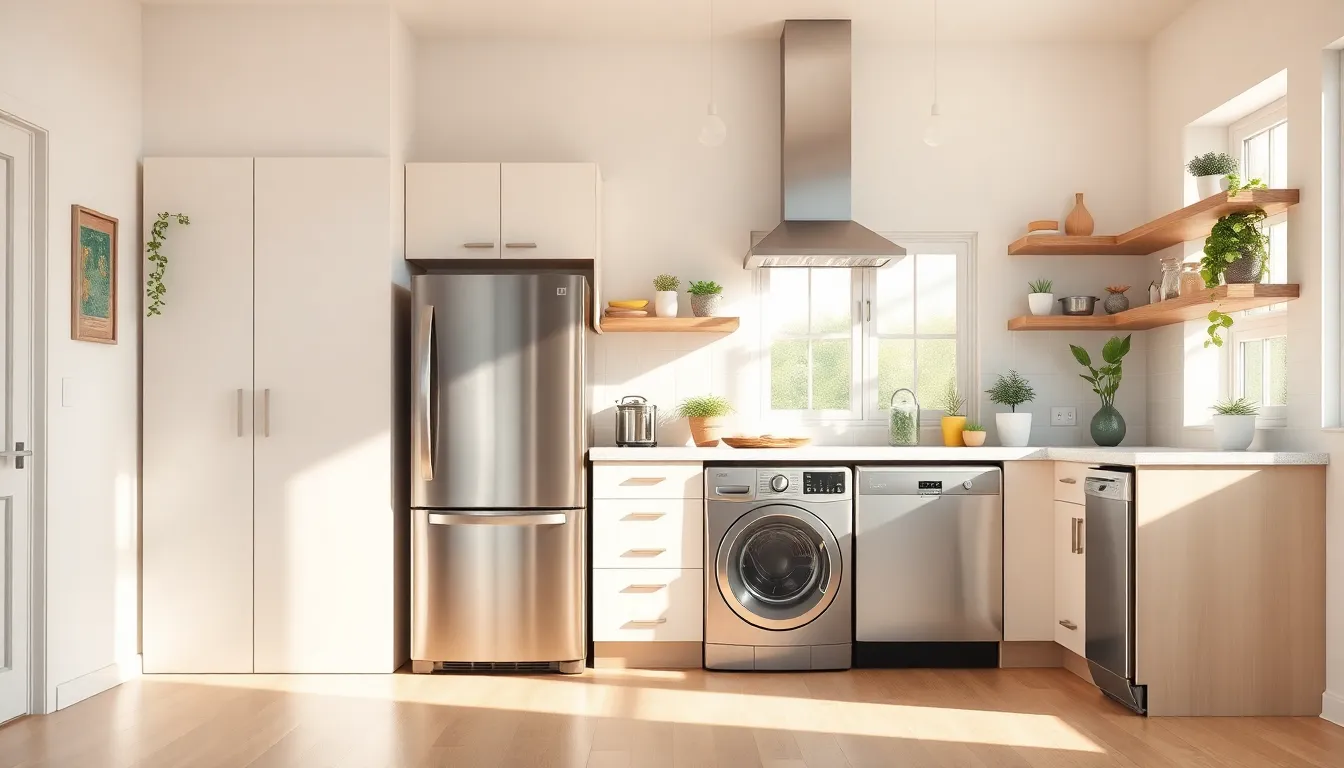Table of Contents
ToggleWhen it comes to home insurance, most people think about protecting their precious belongings and the roof over their heads. But what about those unsung heroes in the background? Yes, we’re talking about home appliances. From your trusty fridge that keeps your midnight snacks cold to the washing machine that bravely battles those mountain-sized laundry piles, these gadgets deserve some love too.
Understanding Home Insurance Appliances
Home insurance extends beyond safeguarding belongings and property. Protecting home appliances is equally essential for a well-rounded policy.
What Are Home Insurance Appliances?
Home insurance appliances refer to essential items like refrigerators, washing machines, and dryers covered under homeowner policies. Policies vary, often including appliance replacement due to unexpected malfunctions or disasters. Coverage might also extend to built-in items, such as dishwashers, where damage arises from covered events like fire or water damage. It’s vital for homeowners to identify specific appliances included in their policies to ensure comprehensive protection.
Importance of Coverage
Coverage for home appliances is crucial for minimizing repair costs. Repairs and replacements can add significant expenses when major appliances fail or encounter damage. Homeowners with adequate coverage benefit from peace of mind, knowing their essential household items receive protection. Claims can help offset financial burdens faced during appliance failures or damages, preserving household functionality. Reviewing policy details ensures understanding of what appliances are covered, allowing for informed decisions on additional coverage options.
Types of Appliances Covered

Home insurance often encompasses various types of appliances, ensuring essential household items receive the protection they deserve. Recognizing the specific categories of covered appliances helps homeowners make informed policy decisions.
Major Appliances
Major appliances include large items that perform essential household functions. Coverage typically extends to refrigerators, ovens, washing machines, dryers, and dishwashers. Each major appliance plays a critical role in daily life, and malfunctions can disrupt home routines. If these items sustain damage from covered perils, such as fire or water damage, homeowners benefit from repair or replacement coverage. Knowing the specific appliances included in the policy allows homeowners to feel secure in their protection.
Small Appliances
Small appliances also receive attention within home insurance policies. Items such as microwaves, toasters, blenders, and coffee makers fall into this category. While not as costly as major appliances, these devices contribute significantly to daily convenience. Coverage for small appliances often protects against unexpected failures and breakdowns due to covered events like power surges. Homeowners should examine their policy details to confirm that essential small appliances are included in their coverage. This ensures that every valuable item, big or small, is accounted for in their home insurance plan.
Factors Affecting Coverage
Home insurance coverage for appliances often varies based on specific considerations. Understanding these factors helps homeowners ensure adequate protection.
Age and Condition of Appliances
Age significantly influences insurance coverage. Older appliances tend to have higher failure rates, making them riskier for insurers. Insurers may limit coverage or apply depreciation, affecting claims. For instance, a ten-year-old refrigerator may receive less compensation than a newer model. Condition matters as well; well-maintained appliances indicate lower risk. Proper upkeep and timely repairs can enhance coverage chances. Homeowners should document maintenance records, as insurers might want evidence to support claims related to aging appliances.
Replacement Costs
Replacement costs play a crucial role in determining coverage amounts. Insurers evaluate the current market value of appliances to ascertain claim payouts. High-end appliances generally come with higher replacement costs compared to standard models. Homeowners must account for such differences when reviewing their policies. Insurers may offer actual cash value or replacement cost coverage options. Knowing which type of coverage is in place helps homeowners ascertain whether their insurance sufficiently covers needed replacements. Homeowners can consider adding riders for specific appliances with significantly higher replacement values.
Tips for Choosing Home Insurance
Choosing home insurance requires careful consideration of multiple factors, especially regarding appliance coverage. Homeowners should prioritize understanding their appliance needs to ensure proper protection.
Assessing Your Appliance Needs
Evaluating the appliances in a home is crucial for choosing appropriate insurance. Major appliances like refrigerators, washing machines, and dishwashers often incur higher repair or replacement costs. Small appliances, while less expensive, still contribute to daily life and should be included in coverage considerations. Homeowners must consider each appliance’s age, condition, and value. Documenting maintenance history can aid in getting claims approved. Knowing which appliances carry the highest replacement costs can help prioritize coverage when selecting a policy.
Comparing Insurance Policies
Researchers should compare multiple insurance policies to find the best coverage for appliances. Different policies provide varying levels of protection, particularly for large or built-in appliances. Reviewing exclusions and limitations helps identify gaps in coverage. High-end appliances may require special riders for adequate protection. Understanding whether a policy offers replacement cost coverage versus actual cash value coverage is also vital. Collecting quotes from various insurers can reveal cost differences and included protections. Homeowners can make informed decisions by analyzing these factors thoroughly.
Home insurance isn’t just about protecting the structure and personal belongings; it also extends to essential appliances that support daily life. By understanding the coverage options available for both major and small appliances, homeowners can ensure they’re adequately protected against unexpected malfunctions or disasters.
Regular maintenance and careful documentation can enhance claims for damaged appliances. Evaluating the age and condition of these items helps in selecting the right policy. With a thorough analysis of coverage types and potential riders, homeowners can secure peace of mind knowing their vital household appliances are safeguarded.





